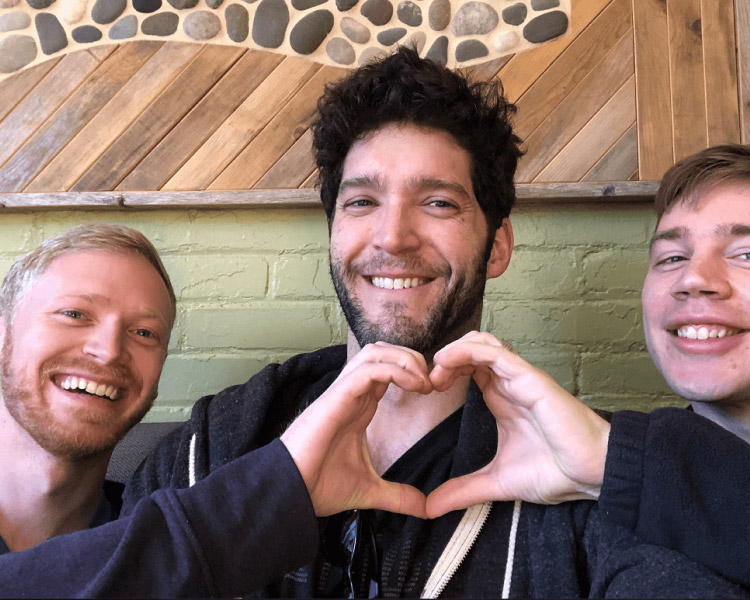Tune into this insightful conversation between Ben Orenstein and Abhi Garg, as they discuss Tuple and Ben’s experience while building non-explosive products that thrive with a community.
Tuple app is an exciting new pair programming tool built for pair programming. Known for its 5K-quality video stream, low latency, and CPU usage, Tuple is here to make you more efficient.
Ben Orenstein is currently building Tuple (as co-founder and CEO), a tool for remote pair programming. Ben is also the creator of Refactoring Rails, and co-creator of Upcase, Trailmix, and Briefs.
Abhi Garg is the Chief Revenue Officer (CRO) at Net Solutions.
Guest: Ben Orenstein
Host: Abhi Garg
Highlights
Tuple came into existence 2.5 years ago when Ben Orenstein pitched the idea of a pair programming app to his friend (now co-founder).
After the slow demise of Screenhero, Ben saw the space left behind by a once-great tool for developers who love pair programming and decided to do something about it. 2.5 years ago, Ben, his friend, and a 3rd co-founder, quit their jobs and started Tuple.
Tuple’s founders bootstrapped it to success. As a reasonably new product, Tuple grew past the point of a sustainable business model, making a steady profit for its founders. Due to its remote nature, the pandemic helped accelerate Tuple’s growth, basically quadrupling the business between January and May 2020.
More about Ben
Ben still identifies himself as a developer more than an entrepreneur, even occasionally sneaking in some coding for Tuple, even though he’s the CEO. With a strong developer background, Ben’s audience and work revolve around coding. Almost all the products Ben has made are developer-related.
How it All Started
Ben fell in love with computers at an early age while studying computer science at school. Deciding to learn Ruby on the side helped Ben get his first job as a Ruby on Rails developer at a cancer research institute. At this institute, Ben explored more by taking up pair programming and learning Vim – eventually making this job a foundation for his programming education.
Have you ever heard of thoughtbot? It’s a prominent Ruby on Rails consultancy where Ben worked for seven years and continued his programming education as he got to work with strong programmers.
At thoughtbot, Ben discovered his interest in entrepreneurship, starting with tiny SaaS apps as side projects, and eventually co-creating Upcase at thoughtbot – an educational product for other Ruby on Rails developers to write better code.
Ben eventually left thoughtbot to work on his products for a while until he started Tuple.
The Impact of Ruby on Rails
The Rails world had a powerful culture of teaching that helped Ben flourish as a developer. Once an underdog language out of Japan, Rails started gaining popularity over time, thanks to the Rails community.
Back then, many passionate people who wanted to succeed taught other people how to use Rails, contributing to its success.
Identifying and Prioritization While Building Products
For Ben, starting an internet company is not attractive. He’s more of a bootstrapper and prefers to self-fund his projects
I don’t want to try to create something that’s going to grow explosively. I want to have a calmer, saner experience.
Ben prefers B2B over B2C simply because consumers are more price sensitive. People won’t pay $100 a month for B2C. A $100 consumer product is reasonably rare; you won’t find many people who pay that much per month.
That’s why he wants to build something for businesses for whom $100 a month is an entirely negligible expense.
Ben’s Experience with All the Products So Far
Trailmix and Briefs were like half projects for Ben. Along with his friend Chris Hunt, he would take a “codecation” – they’d rent a BnB somewhere, book some time off, and go somewhere cool but spend most of their time coding.
They wanted to work on fun non-work things, so they did a couple of these “codecations” and worked on some SaaS products. That’s where they built Trailmix (journaling service) and Briefs (podcast service). Trailmix and Briefs also taught Ben a lot of building products.
Upcase was an education product at thoughtbot, which later became an almost separate division inside the company.
Refactoring Rails is another project that Ben published independently. As a video course for Rails developers, Refactoring Rails turned out to be an excellent chance to learn how to run a business and build a community. It made good money, taught Ben a lot about building an email list, and establishing demand.
Building All those Products acted as Stepping Stones to Tuple
Ben shares how there’s a lot of ways you can go wrong while building a product. You need to learn a ton of skills to solve marketing problems, find customers, not build the wrong thing that no one wants, get the pricing model right, and keep people subscribed.
Tuple
There used to be a tool called Screenhero that allowed you to share your desktop and share remote control with someone else. A lot of developers used it for pair programming. Later Slack acquires Screenhero to integrate it with their app and make it part of Slack calls. Unfortunately, it didn’t work out, and Slack shut Screenhero down.
After failing to find any suitable replacements for Screenhero, Ben realized there was a need in the market for an alternative and pitched his friend that they should do something about it.
So they did. 2.5 years ago, a friend of Ben’s and a 3rd co-founder quit their jobs and started Tuple.
Many of their customers come from Zoom, Slack calls, and Microsoft Teams because the Tuple app is a very high-quality stream of your screen. Why is that important? Because you’re writing/reading code, so it should feel fast and natural. Tuple uses low CPU power and is optimized for programmers.
While getting ready to quit his job, Ben told his coworkers, “We need a name for this thing we’re starting,” and a coworker suggested, “How about Tuple?”
Ben liked it instantly; it kind of sounds like two people. A Tuple is a data structure that takes separate elements and brings them together into one, which is what the app does. It’s like a nerdy little pun. The founders spent a month trying to come up with some other name but couldn’t. So they stuck with the Tuple.
Building Tuple
Their team built two separate prototypes of Tuple that were not native applications. They tried Electron and another approach, but they ran into many performance problems in both cases. The team finally decided, to achieve the performance they wanted, it was worth the pain to write it in C++ and have a native app to hit those goals.
The final version of Tuple was a complete rewrite of the app and also the one they shipped.
Because of C++ and proximity to the OS, Tuple gets more control to deliver low latency and controlled CPU usage.
Tuple works on a combination of Swift and C++.
Pandemic’s effect on Tuple’s growth
Thanks to the push towards more advanced digital means of work, the pandemic helped Tuple find more users and basically quadrupled the business between January and May 2020.
Can Tuple go Big?
For now, Ben isn’t interested in broadening Tuple’s focus for quite a while. He’s happy for people to discover and use his product.
Tuple has the advantage of catering to a niche, and Ben doesn’t want to let go of that quite yet.
Being a developer, product owner, a salesperson, doing marketing, finding new talent, and improving Tuple – how Ben manages running a business with all that responsibility
Ben’s focus changes depending on what the business needs from time-to-time. When they started, he wrote code and made sales to get people to be part of the paid alpha test.
Next, Ben took up marketing responsibilities, but lately, his focus is mostly around hiring – deciding what kind of a team to build and who should be on it.
When to begin Marketing a Product
Ben started very, very early. Based on his experience as a bootstrapped founder, he shares that you should start trying to find people who might need your product and talk to them. Maybe even pre-sell them the product, as he did for the Tuple app.
As he built an audience with an email list and a landing page, Ben wanted to create a community well before they had anything close to a product.
Goal setting for Tuple
Their team’s first significant milestone was profitability. The founders wanted to make enough money to survive, so their first goal was $15,000 in monthly recurring revenue. It was enough money to split among three founders and get by comfortably.
Tuple got to a point where they could sustain, pretty fast, and kept growing ever since.
Managing shipping cadence and updates
Their team released a ton of constant updates in the early days, but lately, they’ve moved to a monthly cadence. Tuple app gets feedback from users saying they want less frequent updates because they use Tuple for work every day and don’t like to update that frequently.
Ben’s team is still working on its development process.
Summarizing “digging a moat” from one of Ben’s Podcasts
Ben thinks of the moat as an enduring, competitive advantage in the market. He’d heard about this approach from Jeff Bezos. Jeff thinks about what things will be valid many years from now and invests in those things.
So if Ben wishes there were more latency in Tuple or used more CPU, he’d feel good about investing in deep technical work that improves those things.
Having a niche is another advantage your business can have; that’s why Ben likes having a niche around pair programming.
Balancing learning and applying what you learn
Ben says he’s almost always reading some book related to his work or tries to find interesting people on Twitter. He actively talks to friends, attends conferences, and stays proactive about seeking out knowledge to improve his position.
I love learning, it’s one of my favorite things.
Ben’s Book Recommendations
- Eating Animals by Jonathan Safran Foer
- No Rules Rules by Reed Hastings and Erin Meyer
Ben’s Favorite Entrepreneur
Ben’s favorite entrepreneur is Patrick Collison, one of the co-founders of Stripe. Ben observes how Patrick is incredibly successful, but in every interview, he comes off as humble, friendly, and very approachable – even though he’s created this amazing thing (Stripe) that’s worth billions of dollars.
He even personally gives out his email so people can give feedback about his products.
What comes after Tuple?
If the Tuple app becomes a massive success, Ben is thinking about getting more involved with startups. So if you’re a startup looking for someone with a strong Rails background and experience in building audiences – think about approaching Ben some time.


